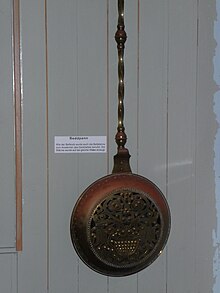Bed warmer

The bed warmer in the form of a lidded bed pan fitted with glowing charcoal was used in early modern Europe to warm the bed . In the 19th century it was replaced by the hot water bottle filled with hot water .
Form and function
The bedpan has the shape of a flat, round bowl, usually with an openwork hinged lid, about 30–40 cm in diameter with a long wooden handle. Pushed back and forth under the pillows, she warmed the beds in the unheated bedrooms of pre-industrial times before going to bed. The hinged lid is mostly made of brass, especially in northern Germany, and more of copper in the south. The basin below can also be made of iron. It has a steeper wall in southern Germany than in the north. The lid decorations with their flower motifs were often sculpted around 1700, then became flatter, simpler, only engraved. Dutch genre pictures sometimes show the bedpan hung next to the bed as room decoration. This form of storage should explain the elaborate decoration of the front side.
History and dissemination
It is believed that the bedpan was made in France; at any rate, several written sources from the 16th century attest to its use at the royal court. As a result, it was particularly widespread in the northern countries of Europe between Lorraine and Lower Germany. The oldest materially preserved examples date from the 17th century, most of them date from the 18th century. They were offered by craftsmen who were properly organized as cymbals or coppersmiths. While the lid decorations with their flower motifs were often sculpted around 1700, they were then flatter, simpler, and often only engraved. For France, the period around 1770 was named for the replacement of the bedpan by the hot water bottle, and English influence was asserted in this context. It probably took longer in German middle-class households. The bedpan survived the longest in rural areas, which is why you can find it today in the folklore departments of museums as evidence of peasant household goods. The pieces offered in the antique trade are often forgeries from recent production.
literature
- Hans Wentzel: bed warmer in: Reallexikon zur Deutschen Kunstgeschichte , Vol. 2, 1938, Sp. 448–452
